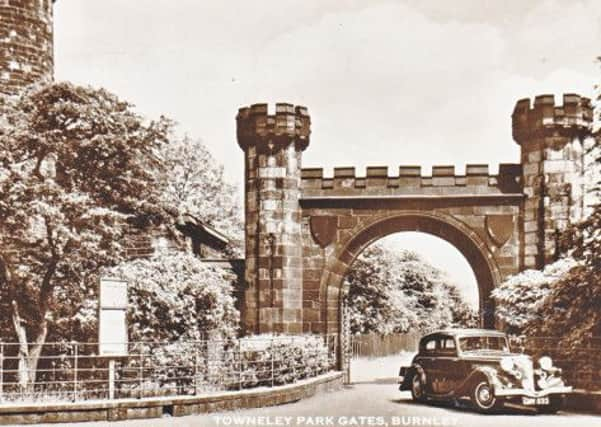An impressive ‘castle’ gateway to Towneley Hall


Though they might be oblivious as to its origins, locals even shorten the name to its dialect form, that of Hanbrig, and they are proud of its “Castle”.
The name Handbridge creates images of people negotiating the former structure by hand rather than foot, but the name has less comic origins.
Advertisement
Hide AdAdvertisement
Hide AdIt comes from the old footbridge which spanned the Calder at this site before the present bridge was constructed in the 19th Century. The footbridge was narrow, made of timber and not always in the best of condition. There was a handrail attached to it to make it safer for pedestrians as there was a danger they might fall into the river which, as many of you will know, can rise very quickly, a factor which brings with it its own dangers.
In the 17th Century, though there are no remains today, the Handbridge area was quite heavily populated.
There were a number of handloom weavers’ cottages at what is now the junction of Lyndhurst Road and Todmorden Road. A second bridge, “Copy Bridge”, another small structure, enabled residents to cross a stream which flowed into the Calder only a few yards away.
It is thought the scientist Richard Towneley (1625-1707) mentioned the waters of the Handbridge area to Dr Leigh, the well-known naturalist and traveller.
Advertisement
Hide AdAdvertisement
Hide AdRichard had noticed a particular spring demonstrated remarkable qualities; when exposed to the air the water deposited coloured sediment, which was identified as natron, otherwise carbonate of soda, which was thought to have restorative qualities. Unfortunately, the discovery was not followed up.
In the 17th Century there were attempts to improve the roads in the Handbridge area. It seems there was a plan to link Eastgate (now Yorkshire Street) to the Huffling Lane area. This would have been via what might have been a private access which followed the route of the present Todmorden Road to Fulledge House. However, the plan was resisted by John Ingham, owner of the Fulledge estate, possibly because an improved highway would have run alongside his own property.
The new road was constructed in the 18th Century and is shown on early maps. The one of 1827 shows the road where it joins Todmorden Turnpike at Brunshaw Bar, by the former Wellington Hotel. The road heads for Fulledge House and then for the Calder at Handbridge where something quite interesting has been built.
Some of us have been accused of building “castles in the air” but few, especially those living in more modern times, can claim to be builders of castles.
Advertisement
Hide AdAdvertisement
Hide AdAt Handbridge, in 1827, there was such a building. It was not a real castle, of course, but it acquired that name and it had been built in the 1790s by Charles Towneley of Towneley. He is more associated with the Towneley Marbles, his splendid collection of classical sculpture which features in the famous painting by Zoffany, now at Towneley Hall.
However, Charles, who, incidentally, spelled his name “Townley”, should be better known for what he achieved in Burnley. He was born in 1737, but, after education abroad, took up residence at Towneley Hall in 1758 where he lived the life of a country gentlemen. Still a young man, he went on the first of his Grand Tours in 1767 when he visited Rome.
The rest of his life was concerned with classical art. In 1791 he became a Fellow of the Royal Society and a Trustee of the British Museum where the Towneley Marbles can still be seen. His only publication was a study of the Ribchester Roman Helmet, one of the finest of its kind ever found. It had been discovered by a village boy, in 1796, on a site near the Ribble at Ribchester, and Charles bought it from the boy’s father. The helmet can also be seen in the British Museum.
At about the same time, Charles was in the process of making improvements to his Towneley estate. In 1788 he had asked Joseph Bonomi to design an extension to the hall which would have included a laundry, brew house, slaughter house, pigsty, poultry yard, ice house, stabling for 28 horses, room for six coaches, harness rooms and saddle rooms around a courtyard with a pond. However, this was not built as originally designed though the present stables (now a café), the ice house and brew house and laundry (now the Local History Museum) were constructed under the direction of Charles and completed in the 1790s.
Advertisement
Hide AdAdvertisement
Hide AdIt is known Mr Towneley undertook a lot of new planting in the park and it was he who, in 1789, with the assistance of his friend, the historian Dr Whitaker, removed, for safe keeping, the Foldy’s Cross from St Peter’s churchyard to Towneley.
The entrances to the park, though, were not particularly impressive and it was this to which Charles turned his attention next. There have been at least four entrances to Towneley in the past. They have been at the top of Red Lees in Cliviger; the East Gate, also in Cliviger; an entrance at Causeway End and another at Handbridge, on what is now Todmorden Road. This latter is better known as Hanbrig Castle and has always been the main entrance to the park.
Charles clearly wanted an impressive entrance and one that would give an indication of the antiquity of the house and park. The structure was designed in the Gothic style, inspired by the architecture of the Middle Ages, but the area around the site was changing rapidly. Not only did the hand loom weavers’ cottages remain, but there was at least one coal mine, with a steam engine, one of Burnley’s earliest, in the vicinity. Charles Towneley might not have realised it but, all too soon, his impressive Gothic Gatehouse would, as both society and the landscape changed, soon be out of place in the new industrial Burnley.